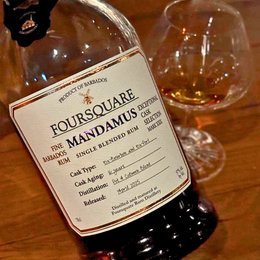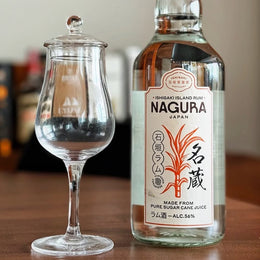Ever since the world has opened up again, I noticed that Angostura rum has been very active in Asia. They’ve been fairly active to the point that they hosted an Angostura cocktail competition for the Philippines earlier this year. Bartenders from other parts of Asia told me that Angostura also tried penetrating the market years before. But nothing really happened. I’m guessing this was largely because most of Asia, and the rest of the world, was still too busy focusing on the whisky and gin craze.
Now that gin isn’t really in anymore, now seems to be a better time. Rum has become the next big thing. Upon checking 88 Bamboo’s archives, I noticed that none of the distillery bottlings have been reviewed. So this is me reviewing a part of their regular bottings.
Let’s see if there’s something to say about Angostura’s premium range of rums. Yes, this is their premium range. The expressions in this list are what they considered their standard rums. I’m guessing they’re standard rums are mainly sold in Trinidad and, maybe, the rest of the Caribbean. While the premium range goes to the rest of the world.

Angostura 5 Year Old – Review
40% abv. £24.95 on The Whisky Exchange. $25 locally.

Color: amber
On the nose: First thing I get is a scorching ethanol heat. Even after letting this sit in the glass for 10 minutes, it’s still that hot. The little aromas I can get from this are coffee, honey, toffee and oak.
In the mouth: Thankfully and weirdly not as scorching as on the nose. There’s this floral sweetness accompanied by a viscous texture that reminds me of the Don Papa Masskara. I taste notes of pears, simple syrup, toffee, caramel, grass jelly, oak and honey. There’s a lingering leather-y and peppery texture.
Conclusion: Throughout my 10 years of taking spirits seriously, I’ve learned that if a spirit gives off a lot of heat, there’s something wrong with the distillate. It’s either the fermentation and/or distillation was made with only “efficiency” in mind. By “efficiency” I mean only getting as much yield as quickly as possible was the focus. Angostura most-likely used a yeast culture that results in a mash with a high abv as quick as possible. Instant dilution and a fast distillation might result in this as well.
How does a column-distilled 40% abv spirit taste this hot? I can see why the brand insists on sweetening this “premium” product. I can also see why the brand hasn’t gotten popular.
Good thing I only bought a sample of this for $3. If I had gotten myself a bottle, I would empty the contents down the sink.
Score: 3/10

Angostura 7 Year Old – Review
40% abv. £29.45 on The Whisky Exchange. $34 locally.
Color: honey
On the nose: Thankfully not as hot as the 5 year; But there’s still quite a bit of ethanol heat.
I get light and fleeting aromas of grass jelly, honey, pears, toffee, caramel, mocha, bay leaf and vanilla.
In the mouth: I mostly get light tastes of sweet, fruity and floral notes. These are bits of pears, honey, toffee, caramel, grass jelly, bay leaf, dried apricots, vanilla and mocha. Like in their 5 year expression, there’s also this viscous texture that reminds me of Don Papa Masskara.
Conclusion: Sweeter in the mouth but not that sweet. So if there’s any added sweeteners to this, it seems like they didn’t add that much. The absence of the scorching ethanol heat makes this a huge improvement over the 5 year which was just a hot mess. Not the appealing kind of hot mess too.
Like most column-distilled spirits, there’s nothing special about this. The distillery DNA relies on the barrel influence for flavor. As much as I dislike Bacardi, their 8 year is better and cheaper than this.
Score: 4/10

The story of Angostura 1919 starts with a fire in 1932. They claim that hundreds of charred casks filled with rum were found at Trinidad’s Government Rum Bond. These casks were filled in 1919 and had been aging for 13 years. (How many times have we heard of stories like this?) This expression’s recipe is now a blend of rums aged between 5 and 14 years.
Angostura 1919 – Review
40% abv. £34.95 on The Whisky Exchange. $40 locally.
Color: gold
On the nose: I get light and short aromas of honey, grass jelly, bay leaf, pears, cacao, browning Fuji apples, mocha, leather, oak and vanilla. At random points of nosing this, I get a rough and peppery texture.
If this rough and peppery texture were from a still with a worm tub, I wouldn’t have minded it. Because, for me, the appeal of a worm tub-distilled spirit is the rough texture. But it’s off-putting when it comes from a multi-column still.
In the mouth: I immediately taste mild notes of toffee, honey, caramel, pears, dried apricots and bay leaf. The viscous texture is greatly lessened here but I still get it. Behind these are more subtle notes of grass jelly, leather, mocha and vanilla.
Conclusion: The improvement of this from the 7 year isn’t that much. However, the slight improvement is also matched by the slight rise in the price. Which isn’t that great so it’s fair. Although, quality-wise, I feel like something with a vintage on the label should taste more premium.
Score: 5/10
Overall Conclusion:
Trying these three hasn’t improved my opinion on the distillery bottlings of Angostura. I feel like the production of these are half-assed. Perhaps the brand will gain success as it’s light and can be presented as “whisky-like”. And this caters to a vast majority of the market. But it’s a no for me.
The persistence of notes like pears and the viscous texture leads me to think that the brand still sweetens their distillery bottlings; Despite them claiming they don’t. But it’s a good sign that they’re not as overly sweet as some other brands who also claim they don’t sweeten their rum.
|
John is a cocktail and spirits enthusiast born and raised in Manila. His interest started with single malts in 2012, before he moved into rum and mezcal in search of malterntaitves – and a passion for travel then helped build his drinks collection. |







